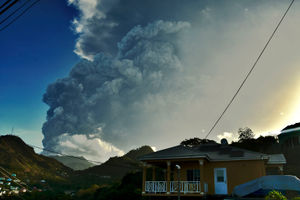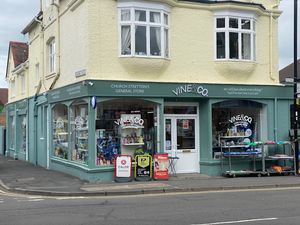'Like an eclipse': Ex-Salopian tells of St Vincent volcano eruption fallout
A former Shropshire woman has been caught up in the fallout of a major volcanic eruption which has forced thousands of people to evacuate their homes in the Caribbean island of St Vincent.

Caroline June lives and works in Barbados, which is about 110 miles east of the stricken island.
Her father Bill Kerswell, who lives near Church Stretton, said: "She told my wife that the sun was completely blotted out, like an eclipse, and the whole of the island was covered in ash.
"Her car and everything around it was covered, with a thick layer of volcanic ash everywhere.
"She has been there for a while. She is a qualified barrister, who was called to the bar in 2007, and moved to Barbados from London.
"She was born in Shropshire. She went to Longnor Primary School, and then to Church Stretton School and then to sixth form in Shrewsbury.
"What has happened shows what I have been saying for some time, that the emissions from volcanoes worldwide like this one in St Vincent are more in one day than the whole of mankind's industry, fires and whatever in 12 months."
Water supplies running short
Leaders in St Vincent have said water is running short as heavy ash contaminates supplies in the wake of the eruption of a volcano on the eastern Caribbean island.
Between 16,000 and 20,000 people have been evacuated from the island’s northern region, where the exploding La Soufriere volcano is located, with more than 3,000 of them staying at more than 80 government shelters.
“We have to get stuff rolling in to people,” Prime Minister Ralph Gonsalves said at a press conference on local station NBC Radio.
But no casualties have been reported since the first big blast from the volcano early on Friday.

“We have to try and keep that record,” he said.
Mr Gonsalves said some people have refused to leave communities closest to the volcano and urged them to evacuate.
He estimated the country will need hundreds of millions of dollars to recover from the eruption, but did not give any details.
Falling ash and pyroclastic flows have destroyed crops and contaminated water reservoirs.
Garth Saunders, minister of the island’s water and sewer authority, noted that some communities have not yet received water.
“The windward (eastern) coast is our biggest challenge today,” he said during the press conference of efforts to deploy water trucks.

“What we are providing is a finite amount. We will run out at some point.”
The prime minister said people in some shelters need food and water, and he thanked neighbouring nations for shipments of items including cots, respiratory masks and water bottles and tanks.
In addition, the World Bank has disbursed 20 million dollars (£14.5 million) to the government of St Vincent as part of an interest-free catastrophe financing programme.
Adam Billing, a retired police officer who lived and tended to his crops on land near the volcano, said he had more than three acres of plantains, tannias, yams and a variety of fruits and estimates he lost more than 9,000 dollars worth of crops.
“Everything that (means) livelihood is gone. Everything,” said Mr Billing, who was evacuated.
“We have to look at the next couple of months as it’s not going to be a quick fix from the government.”

The volcano, which had seen a low-level eruption since December, experienced the first of several major explosions on Friday morning, and volcanologists say activity could continue for weeks.
Another explosion was reported on Tuesday morning, sending another massive plume of ash into the air.
It came on the anniversary of the 1979 eruption, the last one produced by the volcano until Friday morning.
A previous eruption in 1902 killed some 1,600 people.
“It’s still a pretty dangerous volcano,” said Richard Robertson, of the University of the West Indies’ Seismic Research Centre.
“It can still cause serious damage.”





